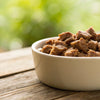How Often to Feed a 1 Month Old Puppy: A Comprehensive Guide for New Pet Owners
- Houndsy
Table of Contents
- Introduction
- Understanding Puppy Nutrition Needs
- Feeding Frequency for a 1 Month Old Puppy
- Choosing the Right Food
- Establishing a Feeding Routine
- Monitoring Feeding Habits
- Potential Health Issues
- Conclusion
- FAQ
Introduction
Welcoming a new puppy into our home is one of the most joyous experiences for any pet lover. Did you know that during the first few months of their lives, puppies grow at an astonishing rate? In fact, they can gain up to 5% of their body weight daily during this crucial period. This rapid growth underscores the importance of proper nutrition, especially when it comes to their feeding schedule. But how often do we feed a 1 month old puppy?
In this blog post, we will explore the best practices for feeding our young puppies, including how many meals they need each day, the types of food that are most appropriate, and the importance of establishing a routine. By the end, you’ll feel confident in providing the best care for your puppy’s nutritional needs.
We'll also discuss how Houndsy’s innovative products, like the Houndsy Kibble Dispenser, can simplify and enhance the feeding experience, ensuring that mealtime is both convenient and enjoyable for us and our furry friends.
Understanding Puppy Nutrition Needs
The Unique Requirements of Puppies
Puppies, particularly those around one month old, have distinct nutritional needs that differ significantly from adult dogs. Their bodies are developing rapidly, requiring high-quality food that supports their growth. At this stage, puppies are transitioning from mother’s milk to solid food, which means that we must be attentive to their eating habits and dietary requirements.
-
Caloric Needs: Puppies need more calories per pound than adult dogs. Generally, they require around 5-6% of their expected adult body weight in calories each day. This means that a 10-pound puppy might need about 500-600 calories daily.
-
Protein and Fat: High protein (around 25-30%) and fat content are essential to support their rapid growth and energy levels. Look for puppy foods formulated to meet these needs.
-
Vitamins and Minerals: Adequate calcium and phosphorus are crucial for bone development. The right balance will help prevent future health issues, particularly in larger breeds.
The Transition from Milk to Solid Food
At one month old, puppies are usually in the process of weaning off their mother's milk, which is rich in nutrients. We can start introducing high-quality puppy kibble at this stage, ideally moistened to make it easier for them to digest. This transition should be gradual to avoid gastrointestinal upset.
Feeding Frequency for a 1 Month Old Puppy
How Often to Feed
For a 1 month old puppy, the general recommendation is to feed them 4 to 5 times a day. Given their small stomachs, frequent meals are necessary to ensure they’re getting enough nutrition without overloading their digestive systems.
Here’s a suggested feeding schedule:
- 7:00 AM - Breakfast
- 10:00 AM - Mid-morning snack
- 1:00 PM - Lunch
- 4:00 PM - Afternoon snack
- 7:00 PM - Dinner
This schedule spaces out meals every three hours, which helps maintain consistent energy levels and supports their developing metabolism.
Signs of Hunger
It’s important to observe our puppies for signs of hunger. If they are whining, pawing at their food bowl, or showing increased interest in food during meal times, it is likely time for their next meal. Additionally, if they consistently leave food in their bowl for longer than 20 minutes, we might be overfeeding them.
Choosing the Right Food
Types of Puppy Food
When selecting food for our 1 month old puppy, we should prioritize high-quality puppy formulations. These are specifically designed to meet the nutrition requirements of growing pups. Here are some popular options:
-
Dry Kibble: Look for high-quality, nutrient-dense dry puppy food. Brands that meet AAFCO standards are generally a safe bet.
-
Wet Food: Canned puppy food can be appetizing for our pups, especially if they are picky eaters. Combining dry and wet food can create a satisfying meal that meets their nutritional needs.
-
Homemade Options: If we prefer to prepare meals at home, ensure that the food is balanced and consult with a veterinarian to confirm the adequacy of the diet.
Avoiding Common Mistakes
While it might be tempting to share our meals with our puppies, it's crucial to avoid feeding them human food, as many common foods can be harmful or even toxic to dogs. Stick to specially formulated puppy food to ensure that we are providing them with the right balance of nutrients.
Establishing a Feeding Routine
The Importance of Consistency
Establishing a consistent feeding routine helps our puppies learn when to expect meals, which can also aid in potty training. Regular feeding times can promote a healthy digestion pattern and prevent accidents in the house.
Measuring Portions
When feeding our puppies, it’s essential to measure their portions according to the guidelines on the food packaging. These guidelines will take into account the puppy's weight and age. As a rule of thumb, we should divide the total daily amount of food into the number of meals we are offering.
Using Tools to Simplify Feeding
To enhance our feeding routine and make it more enjoyable, we can utilize the Houndsy Kibble Dispenser. Designed for convenience and optimal portion control, the Houndsy Kibble Dispenser allows us to dispense the perfect amount of food without the mess. Its modern design fits beautifully into our home decor, making mealtime an aesthetically pleasing experience.
Explore the features of the Houndsy Kibble Dispenser here.
Monitoring Feeding Habits
Tracking Growth and Health
Regularly monitoring our puppy's weight and overall health is crucial. It’s recommended to weigh them every two weeks to ensure they are growing at a healthy rate. A general guideline is to aim for a weight gain of about 10-15% of their body weight each week.
Adjusting the Feeding Schedule
As our puppies grow, their feeding needs will change. By around 3-4 months, we can begin to reduce the number of meals to 3 times a day. This adjustment should be gradual, ensuring that our puppy adjusts comfortably without any digestive issues.
Potential Health Issues
Risks of Overfeeding
Overfeeding can lead to obesity and other health concerns, putting stress on their developing joints. If we notice our puppies are becoming lethargic or gaining weight too quickly, it may be time to reassess their feeding schedule and portions.
Nutritional Deficiencies
Conversely, underfeeding can result in nutritional deficiencies, which can stunt growth and development. If we are ever uncertain about our puppy's diet, consulting with a veterinarian is always a prudent choice.
Conclusion
Feeding our 1 month old puppy properly is essential for their growth, health, and overall well-being. By providing the right nutrition, maintaining a consistent feeding schedule, and using high-quality feeding tools like the Houndsy Kibble Dispenser, we can ensure that our furry friends receive the best start in life.
As we embark on this rewarding journey of puppy parenthood, let’s remember to enjoy the process. After all, mealtimes are not just about nutrition; they’re also opportunities for bonding and creating lasting memories with our pets.
Reflective Questions
- How has your puppy's feeding routine evolved since bringing them home?
- Have you considered how the design and functionality of feeding tools can enhance your feeding experience?
For more information on elevating your dog feeding experience, check out the innovative Houndsy Kibble Dispenser.
FAQ
1. How often should I feed my 1 month old puppy? We should feed a 1 month old puppy 4-5 times a day, spaced every 3 hours.
2. What kind of food should I give my puppy? High-quality puppy food, either dry kibble or wet food, is best for their nutritional needs.
3. How can I tell if I am overfeeding my puppy? If your puppy consistently leaves food in their bowl for longer than 20 minutes or shows signs of lethargy, you may be overfeeding.
4. When should I transition my puppy to adult food? Most puppies can transition to adult food once they reach about 90% of their expected adult weight, typically between 12-18 months depending on the breed.
5. What should I do if my puppy is not eating? If your puppy refuses to eat for more than 24 hours, consult with a veterinarian to rule out any health concerns.









